Wasps are seen across multiple families such as Scoliidae and Tiphiidae. They have varied habitats, often found in or next to man-made buildings.
Multiple species of wasps live in North America. They can live in large nests built under the guidance of a founding queen or in individual nests in the ground or decaying wood.
Table of Contents
Wasp Identification
Wasps are a type of insect with or without wings. They can have no hair, some hair, or be entirely covered in hair. They are known predators and may have a positive role.
Pest bugs often have at least one predator wasp species, especially in the case of moths and their caterpillars.
Color
Wasps have varying colors. The classic yellow and black combination is dominating. They can also come in mostly black colors, blue, red, rust, and brown colors and their combinations.
Size
Wasps generally grow to a size between 9 and 20mm. Some larger species exist as well.
Habitat
Almost all wasp families are terrestrial. They live underground, on trees, under logs or rocks, or in buildings. Some wasps repurpose crevices into nests.
Diet
Adult wasps cannot eat solid food. They prefer nectar as a quick food source. Wasp larvae feed on living and dead insects female adult wasps provide.
Types of Wasps
The following species of wasps are among the most common in the world.
1. Dark Paper Wasp
Some of the most common wasps in North America are the Dark Paper Wasps (Polistes fuscatus). The species is present in an expansive Eastern United States habitat.
These wasps grow to a maximum size of up to 21mm and may be seen in different colors.
Location and gender are what impact the color of the wasps the most.
Females are darker while males have extra yellow sections.
These wasps have a dark red-brown color with black sections across the body. They are social and live next to woodlands as they rely on wood for nesting.
2. European Paper Wasp

European Paper Wasps (Polistes dominula) are smaller than Dark Paper Wasps as they only grow to 13.5mm.
These wasps have been introduced to North America from Europe. Black and yellow coloring are specific to the species.
Female queens lead the nest with secondary females taking over the role of the queen on occasion.
This species feeds caterpillars to its young while it may also consume nectar as a generalist feeder.
3. Bald-faced Hornet

Bald-faced Hornets (Dolichovespula maculata) are black and white yellowjackets that grow to a size of up to 19mm.
The species is known for building large paper nests which are the home of up to 700 wasps.
Paper nests house these wasps for up to 4 months, the typical lifecycle of the species, mainly to September.
Bald-faced Hornets are common in the US and Canada up to Alaska.
Insects and even meat are consumed by these wasps, together with flower nectar.
4. Yellow-legged Mud-dauber Wasp

This species of Sphecid wasps (Sceliphron caementarium) are larger than other common North American species. It grows to a full size between 24 and 28mm.
A mostly black body with yellow species is specific to the appearance of the species. Yellow legs with a few small black sections are distinguished on the wasp.
These wasps are known for building mud nests for their offspring.
They capture spiders which are laid in individual mud nests for the emerging larvae to feed on.
5. Guinea Paper Wasp
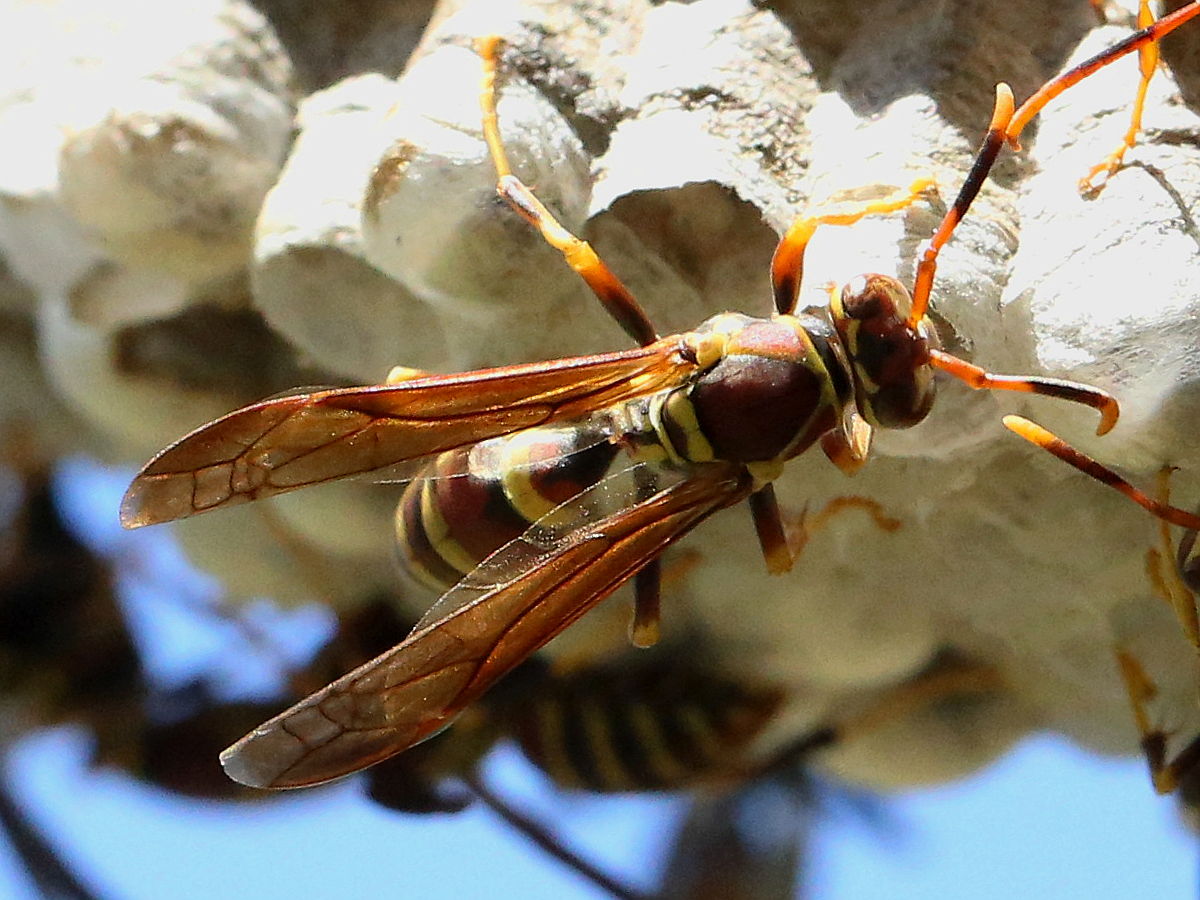
Guinea Paper Wasps (Polistes exclamans) are native to North America. The species grows to 16mm and can be seen each summer, up to September.
These wasps live social lives. Communal living is based on a hierarchy where the dominant wasps are the older ones.
Brown, yellow, and black colors are specific to the species.
They can be seen going in and out of small paper nests with additional satellite nests in the case of large colonies.
These wasps are commonly predated by birds and moths such as the sooty-winged chalcoela.
6. Eastern Cicada-killer Wasp

Also known as Sand hornets, Eastern Cicada-killer Wasps (Sphecius speciosus) are some of the largest types of wasps. They can reach a size of up to 2 inches.
These large wasps look threatening to humans, but it’s only the females that can sting. Eastern Cicada-killer Wasps sting when physically aggressed by humans.
It’s also the females that kill cicadas to use as food for their larvae.
They can be seen around homes looking for in-ground nesting sites and areas where to deposit cicadas.
Paralyzed cicadas are deposited in the ground together with an egg that hatches within 2 weeks.
7. Eastern Yellowjacket

These black and yellow wasps are seen in different sizes. They (Vespula maculifrons) vary in size from 12 to 16mm.
Eastern Yellowjackets live social lives. They have a cast system of queens, workers wasps, and male wasps.
These wasps have a diverse diet as they can eat insects, and scavenge dead insects, fruits, and nectar.
Wasps of this genus are seen waiting for nectar-consuming insects on flowers. They eat nectar and honeydew themselves whenever they cannot catch any insects.
8. Great Golden Digger Wasp

This species of digger wasp (Sphex ichneumoneus) is native to Northern, Central, and South America.
These types of wasps have a red-orange color and a black secondary color. They have reddish legs and
long black antennae.
Females Great Gold Digger Wasps dig individual nests in the ground, closer to other individual nests. They lay insects and eggs in these nests and may show aggressive behavior towards other visiting females.
9. Metric Paper Wasp

This type of wasp (Polistes metricus) is mostly found in North America alone. It has a distinct red color with rust undertones with black and yellow secondary colors.
The species lives in colonies that begin activities in the spring.
Metric Paper Wasps establish nests in places with plenty of natural light and collect different types of insects which they feed to their larvae.
Metric Paper Wasps nests are established by a single reproductive female wasp. Males and worker wasps arise later.
10. Blue-winged Scoliid Wasp

Blue-winged Scoliid Wasps (Scolia dubia) are among the species with dual coloring. They have a black head and a black thorax with an upper black abdomen.
The central and lower parts of the abdomen are red and yellow.
You can differentiate males from females by the shorter length of female antennae.
This species uses grubs as a host for their emerging larvae. Females dig for grubs and lay eggs on top for the emerging larvae to feed on.
11. Great Black Digger Wasp

This type of wasp (Sphex pensylvanicus) is known for its almost completely black appearance. It has a black body and black legs.
Great Black Digger Wasps grow to a size of up to 34mm.
Known to pollinate milkweed, this type of wasps kills insects that are used as hosts for its larvae.
Large insects such as grasshoppers and katydids are often used as food for their growing larvae.
These wasps often fall prey to small birds whenever slowly flying with the captured insect back to the nest.
12. Four-toothed Mason Wasp

This type of wasp (Monobia quadridens) is known to sting. Females have a more painful sting and males use the abdomen for stinging as they don’t have a stinger.
Four-toothed Mason Wasps are mainly black, with yellow bands across its body.
The species also exhibits black wings.
2 generations of the wasps are seen per year. The second generation lays eggs that overwinter and only continue their lifespan in the spring.
These wasps grow up to 18mm.
13. Common Eastern Velvet Ant

This type of wasp (Dasymutilla occidentalis) is among the most common species to be called a velvet ant, due to its ant-mimicking appearance.
Orange-red and black are the main colors of this wasp species.
These wasps are seen flying above the ground and making noises at the same time, particularly as a mating strategy.
Common Eastern Velvet Ants should be avoided as the species has one of the most painful stings in the wasp world.
Males of the species are identified by their black wings. Female Common Eastern Velvet Ants don’t have wings.
14. European Hornet

These wasps (Vespa crabro) have yellow, black, and red-orange colors. They grow up to a maximum size of 35mm.
These types of hornets are seen nesting in hollow trees or hollow wood.
Dead tree branches are among the preferred nesting sites of the species.
European Hornets kill both beneficial and detrimental insects as they can sometimes kill bees.
These types of wasps can also sting if provoked. The sting of the European Hornet is potent but it doesn’t require medical attention in people without allergies.
15. Fraternal Potter Wasp

These wasps (Eumenes fraternus) are small, barely growing to a size larger than 10mm.
Black body coloring and black wings are specific to the species. Narrow yellow bands are seen across its upper and lower abdomen.
The species gets its name from its capacity to build small mud nests similar to small pots as these nests are closed once an egg and a host insect are laid inside.
You can find these small mud nests on vertical surfaces such as walls as this type of positioning allows them to stay safe in the face of many ground-dwelling predators.
16. Gold-marked Thread-waisted Wasp
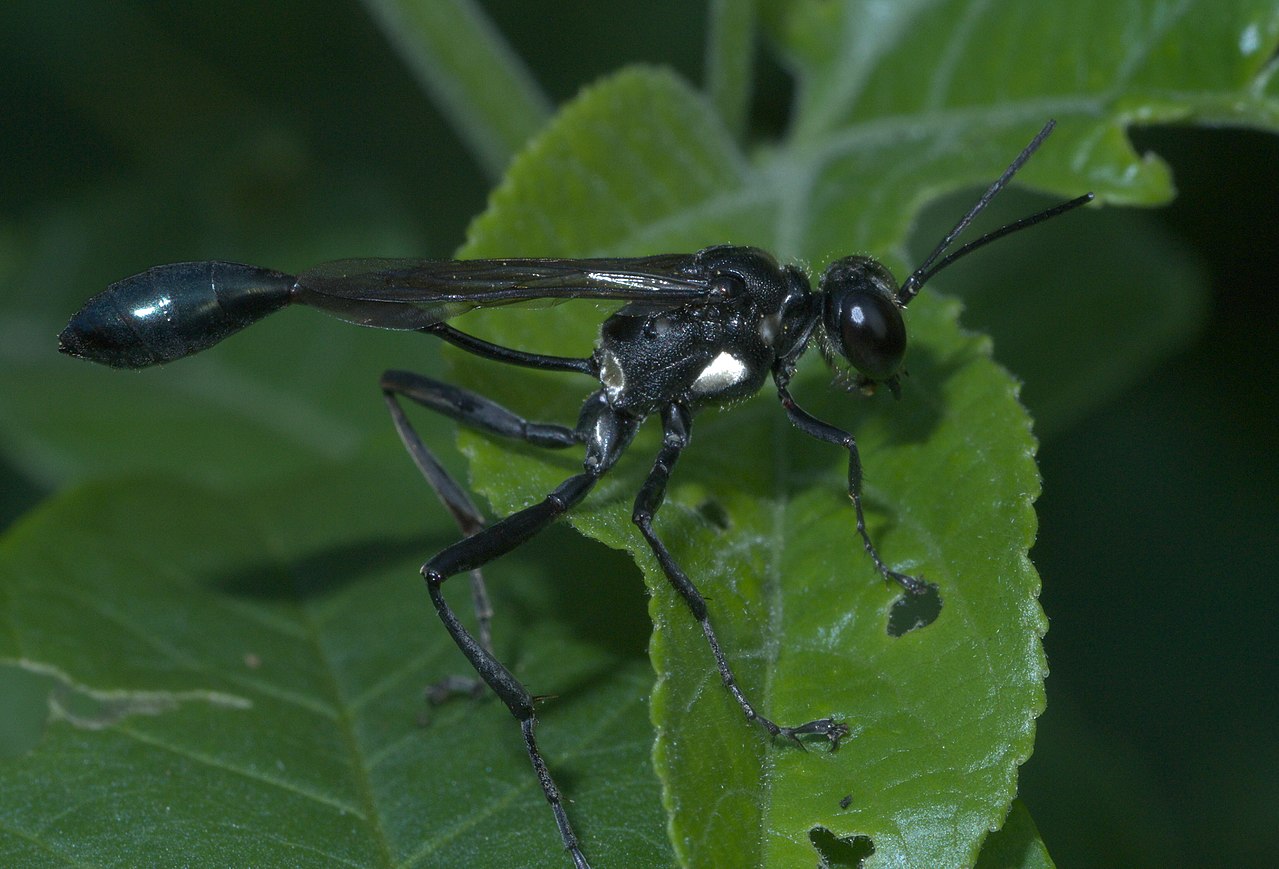
These types of wasps (Eremnophila aureonotata) have distinctly elongated abdomen and almost all-black coloring.
White marks are seen on its thorax.
The species is known to be one of the caterpillar-killer wasps as it lays a single egg on a caterpillar which is used as food by the emerging larvae.
You can find this species across multiple US states, mainly in June, July, and August.
These wasps are often seen feeding on nectar from flowers such as Queen Anne’s Lace in Texas.
17. Nearctic Blue Mud-dauber Wasp

Wasps of this species (Chalybion californicum) are named after their neon blue coloring. A metallic undertone to the blue color is also specific to the species.
Nectar is the main food for the adult Nearctic Blue Mud-dauber Wasp. Wild carrots and the common barberry are plants the species pollinates while looking for nectar.
It’s also a species known to kill the Southern Black Widow spider. This spider is captured to be fed to its emerging larvae.
18. Western Yellowjacket
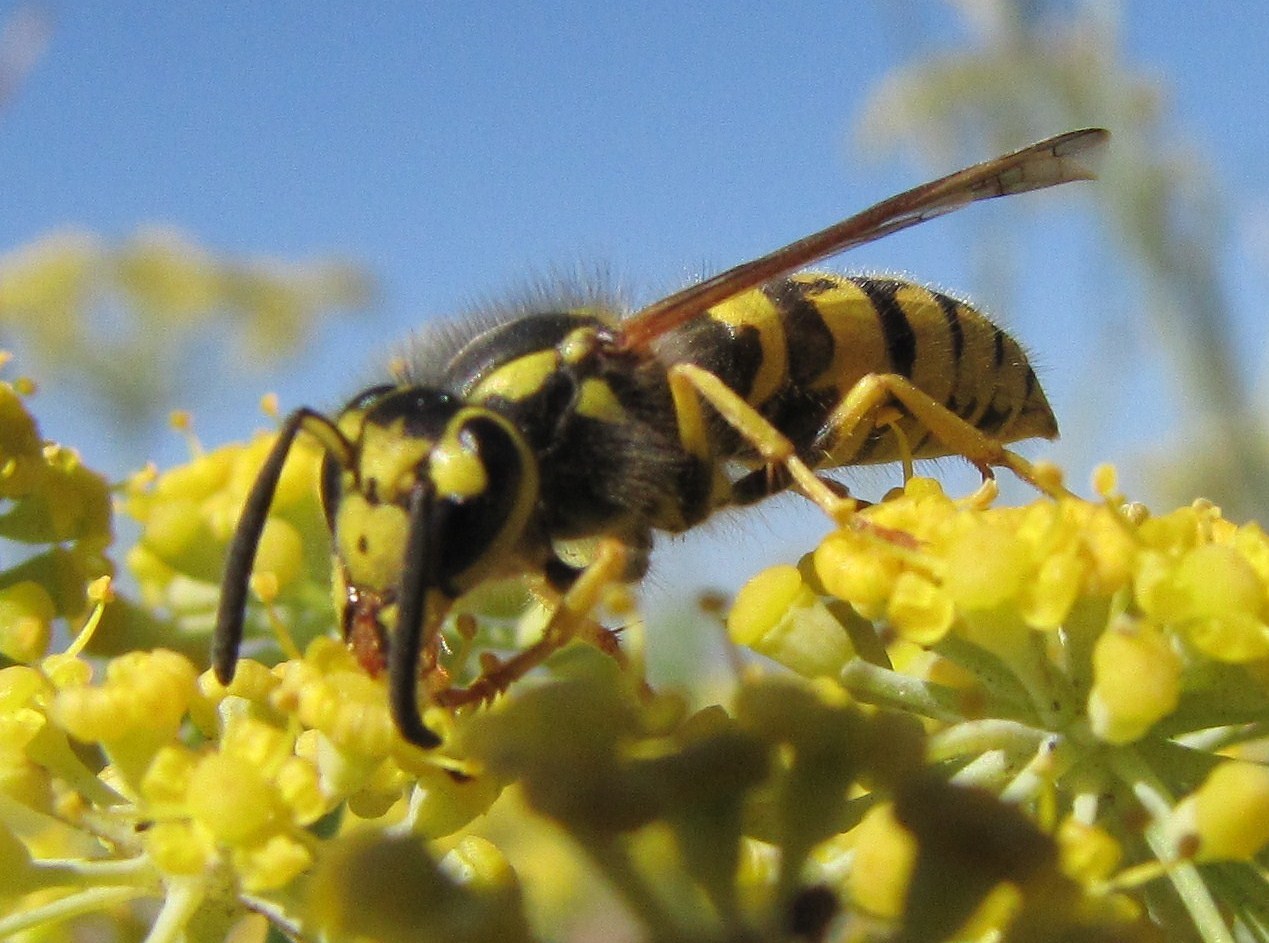
Yellow and black are the main colors of the Western Yellowjacket (Vespula pensylvanica). As its name implies, this is a species with a considerable presence in Western North America.
The species is a known scavenger and predator. It captures all types of spiders and caterpillars. However, the Western Yellowjacket also feeds on dead animal carcasses.
Wasps of this family are known to sting. Their increased numbers in areas with humans make stings a more common occurrence.
They’re likely to stick around garbage cans that they used as a food foraging spot.
19. Southern Yellowjacket

These types of wasps (Vespula squamosa) live in nests but they don’t make honey.
Black and yellow colors are specific to the male while females have black and yellow-orange colors.
Southern Yellowjacket wasps have a varied diet based on insects firsts and nectar in their early larvae growth stages.
Adults feed on live insects and spiders but they can also eat dead insects. Southern Yellowjacket larvae are fed both insects and plant nectar for rapid growth.
These wasps often repurpose the nests of ground hornets.
20. Hunter’s Little Paper Wasp

Southern US states are home to Hunter’s Little Paper Wasp (Polistes dorsalis).
This species grows to a maximum size of up to 17mm and it can be identified by its brown-red color with yellow bands.
Multiple female wasps establish a colony with the first generation of wasps emerging in May.
There’s a queen that leads the colony but all females can lay eggs, even if in lesser numbers.
This species has a potential pest status as it can spread viruses on various cereal crops.
Humans may benefit from studying the venom of this stinging species as it has antimicrobial action.
21. Four-banded Stink Bug Wasp

This type of wasp (Bicyrtes quadrifasciatus) is one of the most common predators of true bugs and stink bugs.
Females can capture and paralyze these bugs which are later offered as food for the emerging larvae.
Four-banded Stink Bug Wasps are most active from June to August.
You can identify the species by its black and pale yellow coloring. Some wasps of this genus have white coloring instead of bright yellow coloring across the abdomen.
The legs of the wasp have a dark yellow color.
Sizing varies across the sexes from 17 to 19mm.
22. Common Aerial Yellowjacket

Black and yellow are the main colors of these wasps (Dolichovespula arenaria). A black body with yellow bands across the abdomen is specific to the species.
Its legs are yellow while its antennae are black.
The species builds nests with paper-like materials high up on trees. This exposes it to certain predators such as birds.
Common Aerial Yellowjackets feed on a large number of bugs such as spiders and grasshoppers. They are also among the common predators of beneficial lady beetles.
Wasps of this genus might also feed on dead animals on occasion.
23. Common Thread-waisted Wasp

This type of wasp (Ammophila procera) has a thin waist that places it in the group of thread-waisted wasps of North America.
An elongated body that’s mostly black and red-brown is specific to the species.
Female Common Thread-waisted Wasps dig nests in the ground. They use these nests to lay eggs and caterpillars as food for the larvae that hatch from the eggs.
Moth caterpillars are preferred by the female that drags the larvae food down into the nest.
24. Pacific Velvet Ant

These types of wasps (Dasymutilla aureola) are native to the West Coast where they inhabit areas of California in high numbers.
This species mimics ants in its fuzzy appearance and even in movements.
Only male Pacific Velvet Ants have wings, mostly used to seek out a potential female partner.
The species has a red-orange color combined with black colors across its legs.
Females of the species are known to have a painful sting.
25. Hump-backed Beewolf

This black and yellow wasp (Philanthus gibbosus) is one of the most common predators of bees in North America.
It sits on pollen-rich flowers awaiting various insects to land before attacking. Bees are among its first targets.
Other predatory species with the same hunting techniques are among the common predators of the Hump-backed Beewolf.
Dragonflies are among the most common predators of the species next to the water while praying mantises are its predators in dry habitats.
26. German Yellowjacket

These wasps (Vespula germanica) are native to North America and Europe. They have black and yellow colors with large black eyes.
German Yellowjackets are generalists and opportunistic feeders. They eat all types of food and they even scavenge.
They can eat live spiders as well as other insects. Dung and human waste are also part of their diet.
German Yellowjackets also eat fruit.
Most wasps of the species grow to a size of up to 11-13mm.
27. Golden Paper Wasp

Golden Paper Wasps (Polistes aurifer) have a golden-yellow color with red-brown marks, stripes, and legs.
The species is native to many Southern US states and fewer Northern states where it has a shorter season.
Golder Paper Wasps are active until November in the South.
The species is also a Mexico native.
These wasps live together socially. They build paper-like nests in all types of areas.
A preference towards areas that are hard to reach for predators is shown in the nest-making habits of the species.
28. Double-banded Scoliid Wasp

The black base color is specific to this wasp (Scolia bicincta) with 2 white bands on the abdomen, as its name implies.
The species has a large size compared to other wasps as it grows to 25mm.
Wasps of this genus are seen from mid-summer to early fall.
They are known for feeding on grubs.
Female Double-banded Scollid Wasps can find grubs in the ground. These grubs are paralyzed and the female can then lay an egg on top so that it has food as it emerges into larvae.
29. Organ-pipe Mud-dauber Wasp

These wasps (Trypoxylon politum) are mostly shiny black. They have long black wings and black antennae.
Molding mud nests is one of the main attributes of the species.
It can use mud to create tubular nests which resemble organ pipes when lined together.
Different types of mud can be used to create these types of nests.
The species is generally seen as a good sign as it kills all types of spiders on crops and around the house.
30. Fine-backed Red Paper Wasp

Fined-backed Red Paper Wasps (Polistes carolina) have a red or red-brown color with black wings.
They are seen as large wasps as they can grow to a length above 30mm.
Wasps of this genus live in colonies established by multiple founding female wasps.
They chew wood to create a paper-like material which is then used to build the nest for the colony.
Attached to trees or ceilings, these nests have an inverted dome shape.
31. Ringed Paper Wasp
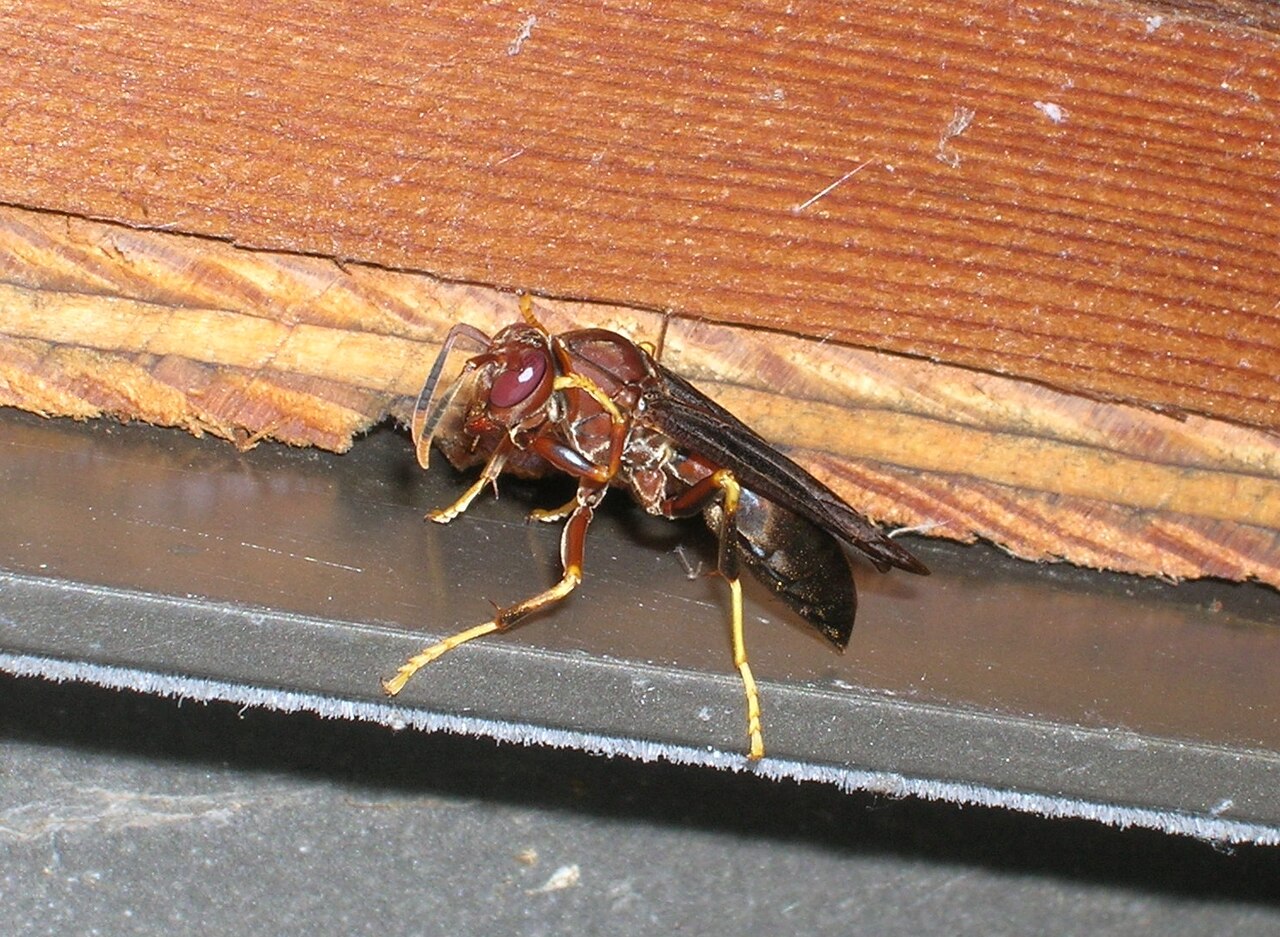
Ringed Paper Wasps (Polistes annularis) have a red and black color with yellow legs.
These eusocial wasps are among the most common around the world when it comes to feeding on caterpillars.
Various species of moth caterpillars are considered by the female wasps as food for their offspring.
Banded wooly bears are among the common types of caterpillar prey.
While these wasps live together in a colony, they also show atypical signs of independence as they often forage on their own.
32. Metallic Bluish-green Cuckoo Wasp

This species (Chrysis angolensis) has a metallic blue color with blue hints in direct sunlight.
Females have long ovipositors but they don’t use them to sting.
Metallic Bluish-green Cuckoo Wasps are known to be parasitic. They feed the larvae of mud dauber wasps to their young as they lay eggs in the nests of mud daubers.
The species has an introduced status in North America where adults of the species are also seen feeding on nectar.
33. Mexican Grass-carrying Wasp
An all-black color is specific to the Mexican Grass-carrying Wasp (Isodontia mexicana). This species has a shiny black color seen across its body, legs, head, and antennae.
Growing to a size between 18 and 20mm, the species is known for using grass to lay its nests which are based on natural cavities.
As its name implies, the species carries grass inside the nest where it also carries its prey.
This species is known to kill grasshoppers and katydids.
Paralyzed insects are carried back to the nest for the emerging larvae.
34. Feather-legged Scoliid Wasp

This scollid wasp (Dielis plumipes) is known for having black and white coloring.
It has alternating black and white bands across its abdomen, thorax, and head. Its wings have a transparent black nuance.
These wasps are parasites of scarab beetles.
Wasps of the species are found in similar appearances both in Eastern and Western North America.
Small differences between members of the species are noted in the length and frequency of the short white hairs that cover its body.
35. Long-tailed Giant Ichneumonid Wasp

These parasitic wasps (Megarhyssa macrurus) are North American natives. They grow to a size of up to 2 inches.
Large and easy to spot on wood and decaying parts of a tree, these wasps are known parasites of the pigeon horntail larvae.
These larvae grow under tree bark in dead areas of the tree or dead trees altogether.
Female Long-tailed Giant Ichneumonid Wasps lay eggs through tree bark, directly in the larvae of pigeon horntails.
36. Noble Scoliid Wasp

Red, black, and yellow is the main color of these North American wasps (Scolia nobilitata).
The species is rather small compared to the Long-tailed Giant Ichneumonid Wasp as it grows to a maximum size of 0.5 inches.
Female Noble Scollid Wasps can detect beetle grubs in the soil. It paralyzes these grubs and injects an egg into them to serve as food for its larvae.
There aren’t many visible differences between the species and other scoliid wasps apart from the shape, size, and vein pattern of its wings.
37. Hidalgo Mason Wasp

This small species of wasps (Euodynerus hidalgo) are characterized by red, black, and yellow colors.
Its thorax is mostly black, with red and yellow bands. Its abdomen is mostly black, with a wider red section and a few narrow yellow bands.
The species grows to a size between 11 and 13mm.
Adults of the species are known to be minor pollinators as they consume plant nectar and pollinate them at the same time.
38. Blue-eyed Ensign Wasp

This species of wasps (Evania appendigaster) is named after its large metallic blue eyes. Its body is all-black and characterized by a thread-like waist.
It’s not clear if this species is native to North America as many think it’s imported from Asia.
Its larvae are parasites of cockroach eggs.
The larvae of Blue-eyed Ensign Wasps have long mandibles which eat through the large eggs of cockroaches.
Not all cockroach eggs are suitable for their larvae. American and Australian cockroaches are among its favorite hosts.
39. American Sand Wasp
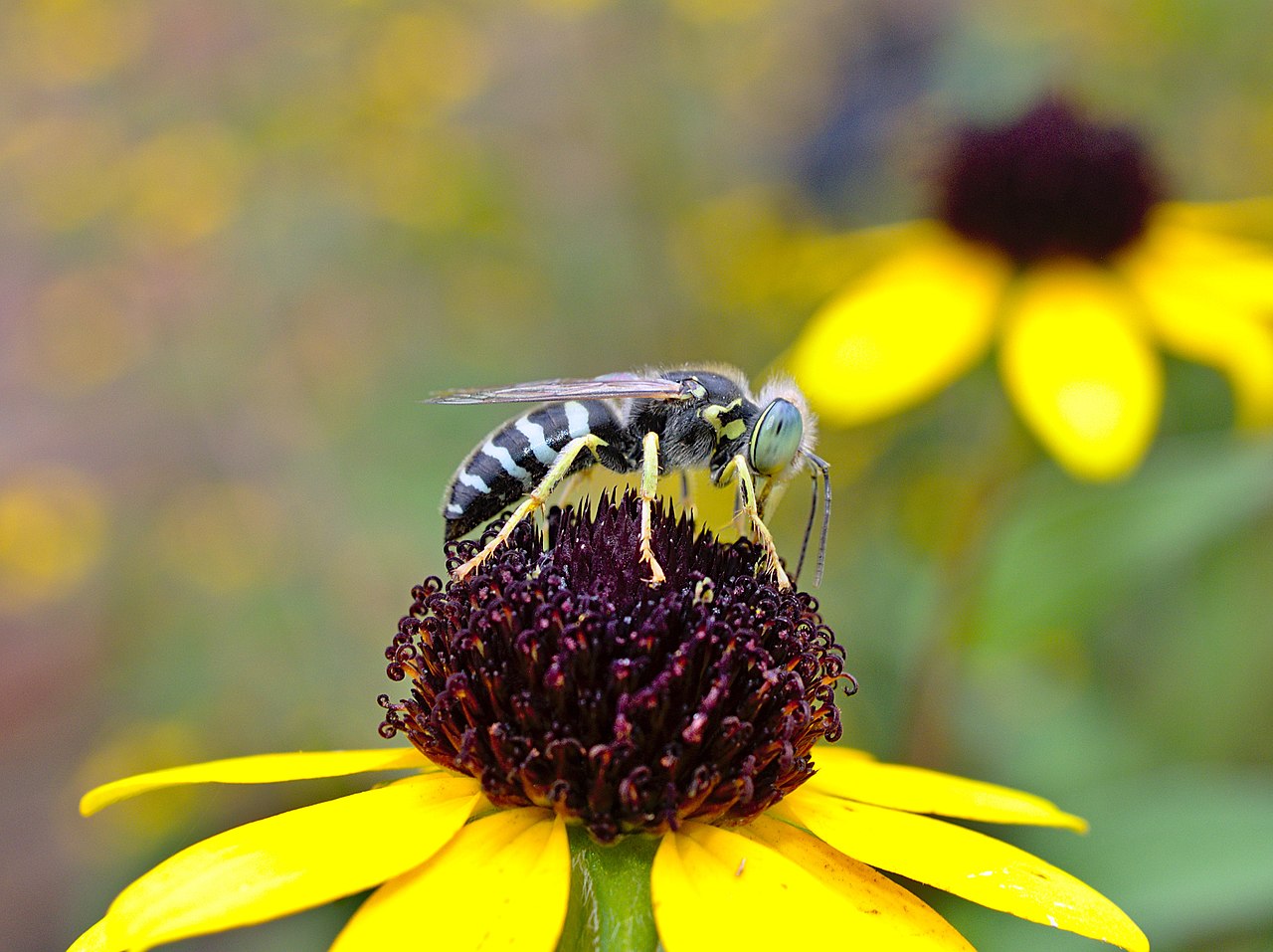
American Sand Wasps (Bembix americana) are native to North and South America.
This species has black and white coloring. A black thorax and head are specific to the wasps.
Alternating black and white bands are seen across its abdomen.
Short white hair covers its body.
American Sand Wasps have yellow legs and large olive-green eyes. They feed on plant nectar as adult wasps.
The larvae of the wasps exclusively feed on insects until emerging as adults. They eat house flies in their larval stage.
40. Apache Paper Wasp

Apache Paper Wasps (Polistes apachus) are some of the largest red and yellow wasps in California.
The species appears common as it routinely builds nests around homes and on garage walls.
Paper-like chewed wood is used to create nests that contain hundreds of cells in which these wasps live and lay eggs.
The larvae of the species are fed moth caterpillars. The native Sooty-winged chalcoela is the primary prey for the species.
People should stay away from these wasps as they have potent venom with a potential for anaphylaxis.
41. American Pelecinid Wasp

These black wasps (Pelecinus polyturator) are among those with very long ovipositors. Some people may associate American Pelecinid Wasps with stinging wasps.
But the role of the long ovipositor is to reach grubs in the ground. Females have the innate capacity to discover grubs in the ground and to lay eggs directly in them.
Females lay fertilized eggs without mating
Most American Pelecinid Wasps are easily spotted as they only fly at low heights, just above the ground.
42. Thisbe’s Tarantula-hawk Wasp

A painful sting is mostly associated with these wasps (Pepsis thisbe).
A dark blue color is specific to this wasp which also has red wings. The species has a large body that grows to a size of up to 44mm.
The potent stinger of females is known to paralyze even tarantulas.
While it’s the females that can sting, male Thisbe’s Tarantula-hawk Wasps may sometimes sting as well.
The pain associated with this sting is ranked among the most important of all insects and biting bugs.
43. Red-marked Pachodynerus Wasp

These rusty-red and black wasps (Pachodynerus erynnis) are also known for their painful sting.
You can find Red-marked Pachodynerus Wasps around nectar-rich flowers. It lives in cavities next to flowers.
Female Red-marked Pachodynerus Wasps prey on different species of caterpillars. Armyworm caterpillars are among its favorite foods for larvae.
The species is seen as highly beneficial on commercial crops as they consume a large number of invasive moth caterpillars.
44. Hornworm Parasitoid Wasp

Eastern North America is the native region of the species, together with Central America.
Hornworm Parasitoid Wasps (Cotesia congregata) are among the smallest North American wasps as they measure anywhere between 2 and 3mm.
These wasps create white tubular cells on plant leaves where they lay eggs and food for the eggs.
Various species of caterpillars are considered good food for their larvae.
Virginia creeper sphinx and paw paw creeper sphinx larvae are among the most common foods for their larvae.
45. Steel-blue Cricket-hunter Wasp

Dark blue color with metallic undertones is dominant on the body of the Steel-blue Cricket-hunter Wasp (Chlorion aerarium).
Its wings are mostly black.
Crickets are the main food source for the Steel-blue Cricket-hunter Wasp larvae.
Larvae are grouped for easier feeding.
Female Steel-blue Cricket-hunter Wasps lay up to 9 eggs in a single cell.
A large cricket is then shared between the larvae in a single cell as the female wasp can transport the bug back to the nest relying on strong mandibles.
46. Coarse-backed Red Paper Wasp

This species (Polistes rubiginosus) is mostly rusty red with black and brown secondary colors. Growing to a size of up to 18mm, the species is a North American native.
It nests in available wood cavities such as in trees and wooden buildings.
The species is seen feeding on goldenrod during the day.
47. Rusty Spider Wasp

A rusty red color with metallic blue wings dominates the appearance of the Rusty Spider Wasp (Tachypompilus ferrugineus).
This species of wasp kill spiders a few times larger than itself.
Large wolf spiders and grass funnel spiders are among its common victims. It feeds the spiders to its young.
48. Katydid Wasp
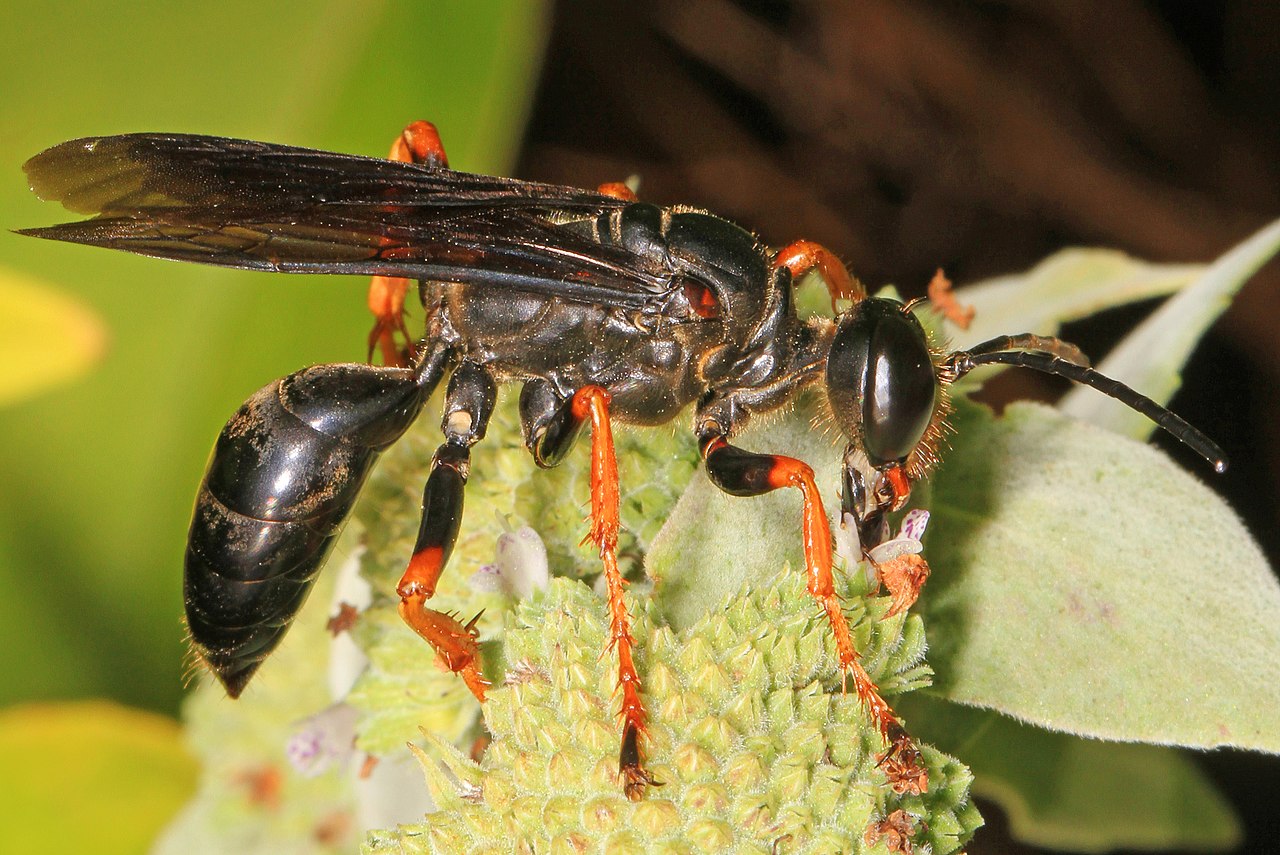
This type of wasp (Sphex nudus) has a dark brown-black color with red or red-orange legs.
Katydid Wasps grow to a size between 20 and 25mm.
Native to Southeastern US territories, the thread-waist wasp feeds on nectar while its larvae are fed paralyzed katydids.
49. Five-banded Thynnid Wasp

This species (Myzinum quinquecinctum) is known for having a black body with yellow bands.
It can be found in a vast Eastern North American habitat.
Five-banded Thynnid Wasps find beetle grubs which they paralyze with a short string. This grub serves as a host for the female’s egg.
50. Bramble Mason Wasp

This type of mason wasp (Ancistrocerus adiabatus) has a small body size. It grows to 11mm as an adult.
The mostly black color with yellow bands is specific to this species.
This species builds its small mud nests for its eggs. The role of these sheltered nests is to protect the eggs from predators.
51. Widow Yellowjacket

Widow Yellowjackets (Vespula vidua) have a black and yellow appearance with smoky brown wings.
The species feeds on plant nectar as an adult while its larvae feed on caterpillars.
Females chew caterpillar parts for the larvae to feed on easier. You can find Widow Yellowjackets in Northeastern US regions.
52. Alaska Yellowjacket

This species (Vespula alascensis) is one of the Northern yellowjackets. It has black and yellow coloring with smoky brown wings.
It feeds on nectar, fruit, and carrion as an adult.
Its adaptation to cool climates means the Alaska Yellowjacket remains active until November.
53. Black Giant Ichneumonid Wasp

This type of large wasp (Megarhyssa atrata) is a known predator of pigeon horntail caterpillar which it feeds to its young.
It looks for these caterpillars in pieces of dead wood.
Dead trees and logs are among the most common places to see these wasps. They always rest in hidden places to stay away from predators.
54. Southern Paper Wasp

These paper wasps (Polistes bellicosus) have a red color with yellow and black bands across.
Native to Florida, the species begins life in the spring when overwintering queens establish new colonies with a clear hierarchy.
These wasps build paper-like nests from sheds of masticated loose wood fibers.
Many of these nests are destroyed by birds and other predators.
55. Horse’s Paper Wasp

Mostly common in Central America, this species of wasps (Polistes major) are mostly yellow, with red and black bands across the body.
It feeds on plant nectar but it preys on caterpillars and treehopper bugs which it chews for its emerging larvae.
Woodpeckers are some of the major predators of the species.
56. Mexican Paper Wasp

Brown red color and a very long ovipositor on females are specific to the Mexican Paper Wasp (Mischocyttarus mexicanus).
Adults eat liquids such as nectars from cabbage palms and other types of trees and plants. The larvae of the species are fed caterpillars and chewed spiders.
Mexican Paper Wasps live in colonies under the rule of a queen. The colony may or may not survive the queen’s death.
57. Sacken’s Velvet Ant

This type of wasp (Dasymutilla sackenii) mimics ants. It has a black body covered in scarce long white hairs.
These hairs only cover the lower part of its abdomen and its thorax.
Females are wingless while males have wings. These types of wasps build individual nests in the ground.
58. Toltec Scoliid Wasp

Toltec Scollid Wasps (Dielis tolteca) are native to Southern US territories such as Southern Texas.
Black and yellow colors are specific to the species. Wide yellow bands cover its abdomen.
Adults Toltec Scoliid Wasps feed on plant nectar. They prefer asters such as yellow solidago.
59. Western Paper Wasp

Native to the US, Western Paper Wasps (Mischocyttarus flavitarsis) are a common sight among human settlements and woodlands, particularly those close to water.
The species feeds on nectar as adult wasps.
Larvae are feed insects and nectar within the nest, mostly carried by females.
60. Lobed Mason Wasp

Lobed Mason Wasps (Ancistrocerus antilope) are native to North America. They cover a region expanding from Florida to the Southern parts of Alaska.
A shiny black body with yellow bands is specific to Lobed Mason Wasps.
The species has smoky brown wings close to the body and opaque black wing tips.
61. Klug’s Velvet Ant

Ant mimicry is the main trait of Klug’s Velvet Ants (Dasymutilla klugii). Native to Southern US regions, the species has a black and red or red-brown fuzzy body.
Its thorax and upper abdomen are black while the lower abdomen is red or orange.
The species lives in the ground and it may sting if roughly handled.
62. Golden-reined Digger Wasp
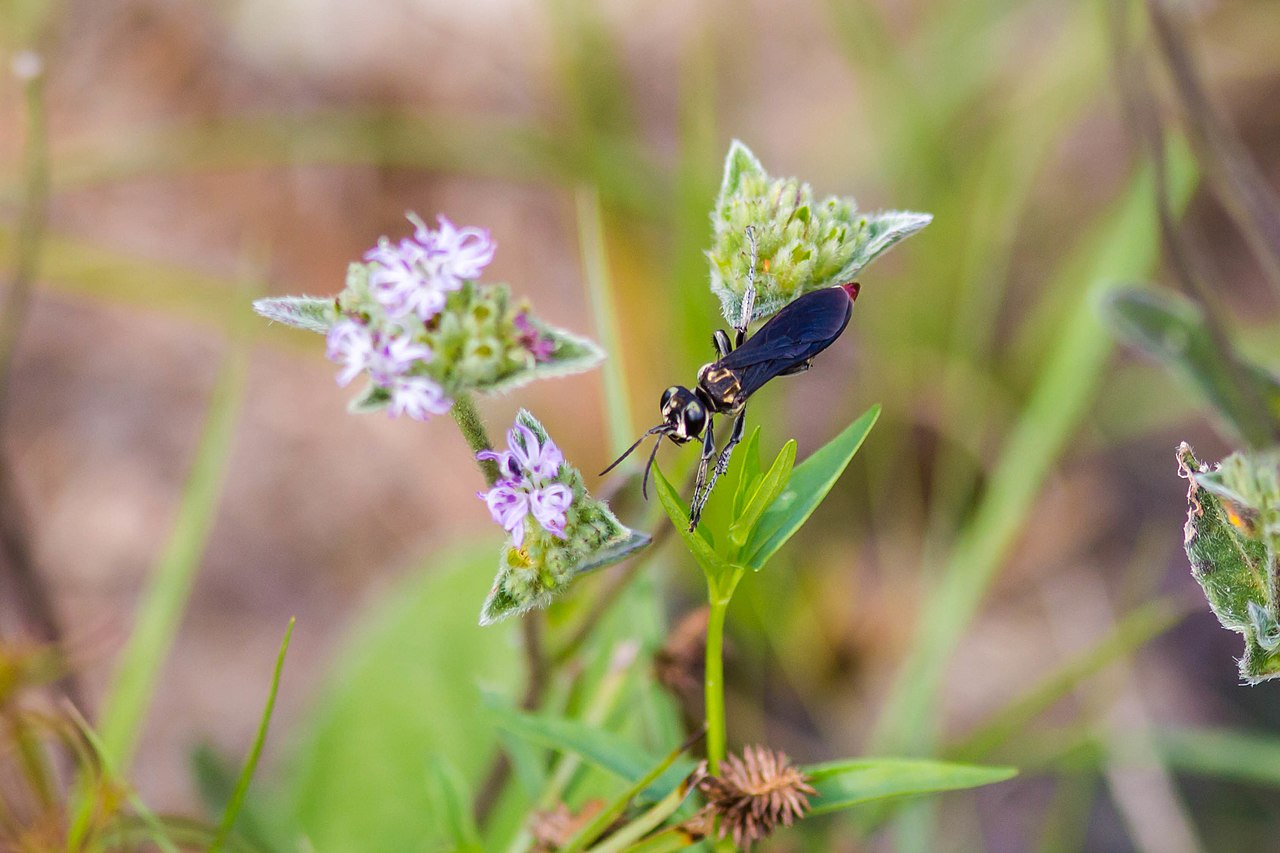
A common sight on flowers, this wasp species (Sphex habenus) grows up to a size of 29mm. Males are larger than females.
Adult Golden-reined Digger Wasps feed on plant nectar.
They have a yellow and black thorax and a red to brown abdomen.
Active until October, these wasps nest in the ground.
63. Smiling Mason Wasp

This species of wasp (Ancistrocerus campestris) has a reduced size as it can measure anywhere between 9 and 11mm.
A black and yellow wasp, the Smiling Mason Wasp is identified by the smiling face coloring.
The wasps are a known predator of Amphisbatinae moth caterpillars.
64. Brown-legged Grass-carrying Wasp

A black-blue color is specific to the Brown-legged Grass-carrying Wasp (Isodontia auripes).
The species uses grass to line existing cavities which it uses as nests.
A single chamber in its grass-lined nests can host multiple larvae. The species is active through the summer in Southern US states and only up until August in Northern states.
65. Downy Yellowjacket

Downy Yellowjackets (Vespula flavopilosa) can build nests both in the ground and above the ground in existing crevices.
The species is seen across Northeastern US states and is identified by its black and yellow colors.
Alternating black and yellow bands are seen across its abdomen and thorax.
The species has elongated black antennae.